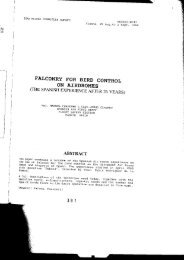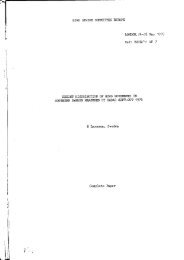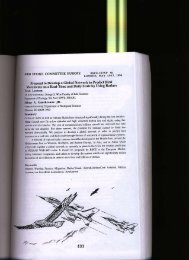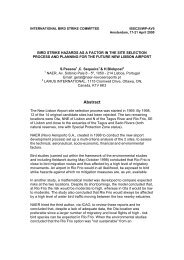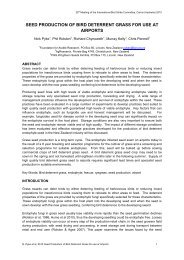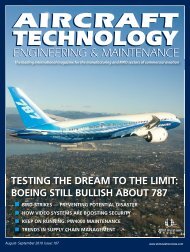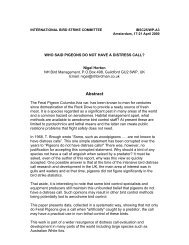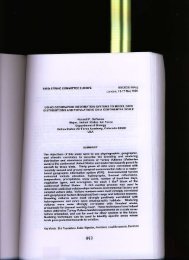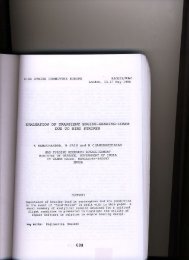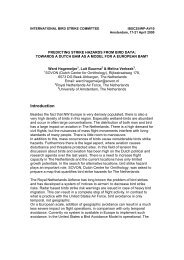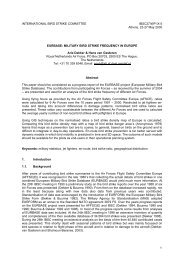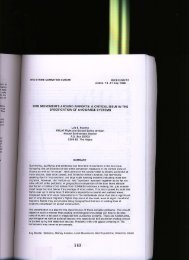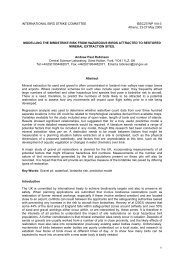Standards for aerodrome bird/wildlife control - International Bird ...
Standards for aerodrome bird/wildlife control - International Bird ...
Standards for aerodrome bird/wildlife control - International Bird ...
You also want an ePaper? Increase the reach of your titles
YUMPU automatically turns print PDFs into web optimized ePapers that Google loves.
Whilst the reference to garbage dumps is clear, ‘any such other source attracting <strong>bird</strong><br />
activity’ requires a significant degree of interpretation. As with the <strong>bird</strong>/<strong>wildlife</strong><br />
attractions on the <strong>aerodrome</strong>, airport managers may need to seek assistance <strong>for</strong>m<br />
specialists when identifying the major <strong>bird</strong>/<strong>wildlife</strong> attractions near their airport. They<br />
will certainly require some assistance in assessing whether the <strong>bird</strong>s/<strong>wildlife</strong> using<br />
such a site pose a significant risk to flight safety, as this needs an understanding of<br />
ecology and behaviour that is unlikely to be available from within the airport’s own<br />
staff.<br />
Management<br />
Once sites that support <strong>bird</strong>s/<strong>wildlife</strong> that are, or might, cause a flight safety problem<br />
are identified, management options can be developed. These can range from minor<br />
habitat modification, changing cropping or other agricultural practices, major drainage<br />
operations or large scale removal of <strong>bird</strong>/<strong>wildlife</strong> populations. Again the choice of<br />
technique will depend on the particular situation encountered and expert advice<br />
should be sought if necessary. Larger scale off-airport <strong>bird</strong>/<strong>wildlife</strong> management may<br />
also involve liaison with local conservation interests, especially if the sites that need<br />
to be managed are nature reserves. In some cases it may be impossible to resolve<br />
the conflicting interests of flight safety and conservation, but in trying to do so the<br />
airport will be in a better position to show due diligence in the event of an accident or<br />
legal claim in the future.<br />
Standard 9<br />
Airports should conduct an inventory of <strong>bird</strong> attracting sites within the ICAO<br />
defined 13km <strong>bird</strong> circle, paying particular attention to sites close to the<br />
airfield and the approach and departure corridors. A basic risk assessment<br />
should be carried out to determine whether the movement patterns of<br />
<strong>bird</strong>s/<strong>wildlife</strong> attracted to these sites means that they cause, or may cause, a<br />
risk to air traffic. If this is the case, options <strong>for</strong> <strong>bird</strong> management at the site(s)<br />
concerned should be developed and a more detailed risk assessment<br />
per<strong>for</strong>med to determine if it is possible and/or cost effective to implement<br />
management processes at the site(s) concerned. This process should be<br />
repeated annually to identify new sites or changes in the risk levels produced<br />
by existing sites.<br />
Where national laws permit, airports, or airport authorities, should seek to<br />
have an input into planning decisions and land use practices within the 13km<br />
<strong>bird</strong> circle <strong>for</strong> any development that may attract significant numbers of<br />
hazardous <strong>bird</strong>s/<strong>wildlife</strong>. Such developments should be subjected to a similar<br />
risk assessment process as described above and changes sought, or the<br />
proposal opposed, if a significant increase in <strong>bird</strong>strike risk is likely to result.<br />
18



